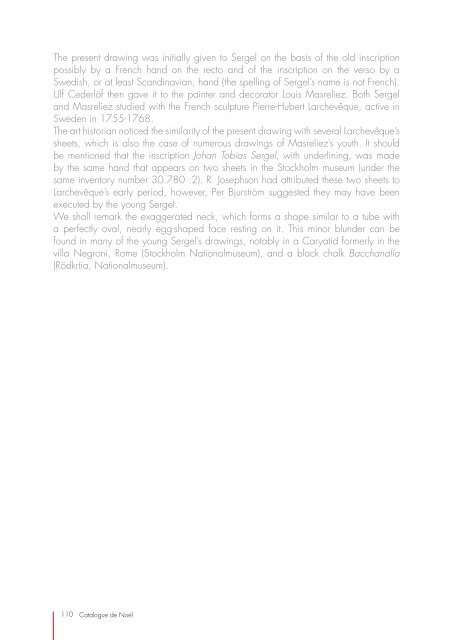Create successful ePaper yourself
Turn your PDF publications into a flip-book with our unique Google optimized e-Paper software.
The present drawing was initially given to Sergel on the basis of the old inscription<br />
possibly by a French hand on the recto and of the inscription on the verso by a<br />
Swedish, or at least Scandinavian, hand (the spelling of Sergel’s name is not French).<br />
Ulf Ce<strong>de</strong>rlöf then gave it to the painter and <strong>de</strong>corator Louis Masreliez. Both Sergel<br />
and Masreliez studied with the French sculpture Pierre-Hubert Larchevêque, active in<br />
Swe<strong>de</strong>n in 1755-1768.<br />
The art historian noticed the similarity of the present drawing with several Larchevêque’s<br />
sheets, which is also the case of numerous drawings of Masreliez’s youth. It should<br />
be mentioned that the inscription Johan Tobias Sergel, with un<strong>de</strong>rlining, was ma<strong>de</strong><br />
by the same hand that appears on two sheets in the Stockholm museum (un<strong>de</strong>r the<br />
same inventory number 30.780 :2). R. Josephson had attributed these two sheets to<br />
Larchevêque’s early period, however, Per Bjurström suggested they may have been<br />
executed by the young Sergel.<br />
We shall remark the exaggerated neck, which forms a shape similar to a tube with<br />
a perfectly oval, nearly egg-shaped face resting on it. This minor blun<strong>de</strong>r can be<br />
found in many of the young Sergel’s drawings, notably in a Caryatid formerly in the<br />
villa Negroni, Rome (Stockholm Nationalmuseum), and a black chalk Bacchanalia<br />
(Rödkrtia, Nationalmuseum).<br />
110<br />
<strong>Catalogue</strong> <strong>de</strong> Noël
















